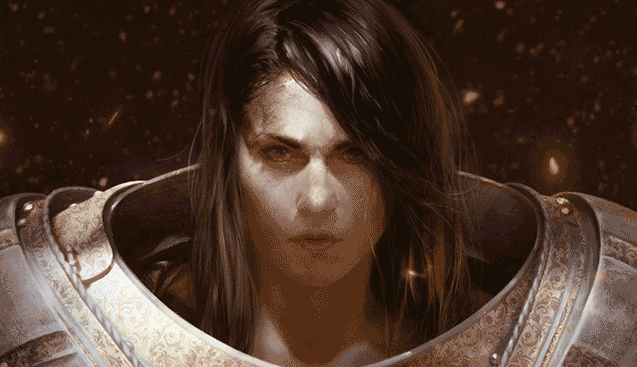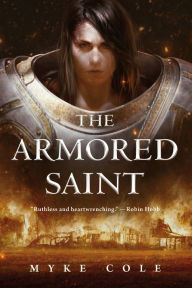The Armored Saint: New Genre, Same Myke Cole Experience
 So you have some questions about The Armored Saint by Myke Cole, book one of The Sacred Throne series:
So you have some questions about The Armored Saint by Myke Cole, book one of The Sacred Throne series:
The Armored Saint (Sacred Throne Series #1)
The Armored Saint (Sacred Throne Series #1)
By Myke Cole
Hardcover $17.99
Hey, isn’t this a new genre for Myke Cole?
Yes! The Armored Saint is a straight up fantasy, a new genre for Cole, who is best known for his immersive, fast-paced Shadow Ops military fantasy books.
Does the “Armored’ part mean it has knights in it?
Sort of? The story has elements of steampunk in how the armor is created and how it functions, but to explain more would be spoilery. (Though the cover image is accurate enough.)
However, there is also what we’d probably term a religious order of knights, but from their first appearance, it’s clear they’re not the noble kind of knights.
Does the woman on the cover mean there’s no male protagonist?
Correct. The protagonist—the title character, Heloise—is a young woman: smart, somewhat innocent, idealistic, and determined.
Is it anything like Cole’s other books?
Yes, despite the divergent genre, it has some elements in common. It’s intensely fast-paced, it includes horrific descriptions of death and destruction (though no zombies this time), and the characters are complex, three-dimensional people fighting evil in several forms.
The major difference between The Armored Saint and the Shadow Ops books is that the lead character’s voice in this one is younger and more idealistic, in contrast to Cole’s military heroes, who tend to be more cynical and snarkier. Heloise is an earnest soul.
Will I like it if I’ve liked his other books?
Absolutely.
It’s a compelling tale that sucked me in from the opening scene. My only complaint is that the ending is very much a “to be continued,” but, happily, The Queen of Crows, book two of The Sacred Throne, will be released on October 16 of this year.
In the acknowledgments page, Cole speaks about why he wrote this book:
“I’ve always tried to push the envelope of my writing with each book, but the one you’re holding in your hand represents the biggest leap I’ve ever made.”
It’s a leap that has paid off.
What’s it all about?
The sides of right and wrong are absolutely clear in this book. What’s uncertain are the choices faced by all our characters. Doing the right thing may have terrible consequences. Doing the wrong thing may help Heloise and her family survive, at least in the short term.
In this world, a religious order of knight protectors has been created to oppose literal demons who can enter the world via human portals, supposedly through the eyes. But, in the years since the demons were defeated, what they’ve really become are tyrants swelled by their own power, willing to abuse and destroy the very people they’re supposed to protect, under the guise of doing what’s “best” for them.
Heloise and her father Samson are part of a community that takes care of its own—a typical small town where nothing seems to happen. But that doesn’t mean they’re out of the reach of the religious order’s tyranny.
In an absolutely chilling early sequence, the knights round up Heloise and the other villagers to help purge a neighboring community supposedly infected by demons. Heloise cannot remain compliant in the face of such cruelty, including the murder of a young girl—and neither can Samson, nor a number of the others. Their unwillingness to turn a blind eye seals their fates, and the fates of many others.
Heloise’s must decide whether is it justifiable to protect you and yours from evil by staying silent, even if it means letting others be destroyed. She answers that question with an emphatic “no.” She cannot abide tyranny, and her only regret is that she’s put others in danger. That Heloise is romantically interested in her female best friend only adds to the contemporary resonance of the choices she faces.
In the last third of the book, more of the world reveals itself, and we come to realize why demons caused the kind of fear that resulted in the order’s creation. It’s not that the order is revealed to be justified in its actions, but we do come to understand that they may be a necessary evil.
And it’s then that Heloise lives us to the promise of the cover, as she becomes the “armored saint” of the title.
I pondered her choices long after I finished reading. That order’s contempt for outsiders has parallels in our current news cycle is not in question. There’s also a larger point to be made about the tragedy that occurs when those sworn to protect become so corrupted by power and callousness that they’ve left those who need protection vulnerable.
Yet even if you’re not in the mood to ponder the heavy questions, you’ll still find this a most satisfying fantasy, with terrific action sequences, particularly once Heloise dons the armor and takes her place as protector. She’s a fascinating character in a fascinating fantasy world, and I’m glad to have met her.
The Armored Saint is available now.
Hey, isn’t this a new genre for Myke Cole?
Yes! The Armored Saint is a straight up fantasy, a new genre for Cole, who is best known for his immersive, fast-paced Shadow Ops military fantasy books.
Does the “Armored’ part mean it has knights in it?
Sort of? The story has elements of steampunk in how the armor is created and how it functions, but to explain more would be spoilery. (Though the cover image is accurate enough.)
However, there is also what we’d probably term a religious order of knights, but from their first appearance, it’s clear they’re not the noble kind of knights.
Does the woman on the cover mean there’s no male protagonist?
Correct. The protagonist—the title character, Heloise—is a young woman: smart, somewhat innocent, idealistic, and determined.
Is it anything like Cole’s other books?
Yes, despite the divergent genre, it has some elements in common. It’s intensely fast-paced, it includes horrific descriptions of death and destruction (though no zombies this time), and the characters are complex, three-dimensional people fighting evil in several forms.
The major difference between The Armored Saint and the Shadow Ops books is that the lead character’s voice in this one is younger and more idealistic, in contrast to Cole’s military heroes, who tend to be more cynical and snarkier. Heloise is an earnest soul.
Will I like it if I’ve liked his other books?
Absolutely.
It’s a compelling tale that sucked me in from the opening scene. My only complaint is that the ending is very much a “to be continued,” but, happily, The Queen of Crows, book two of The Sacred Throne, will be released on October 16 of this year.
In the acknowledgments page, Cole speaks about why he wrote this book:
“I’ve always tried to push the envelope of my writing with each book, but the one you’re holding in your hand represents the biggest leap I’ve ever made.”
It’s a leap that has paid off.
What’s it all about?
The sides of right and wrong are absolutely clear in this book. What’s uncertain are the choices faced by all our characters. Doing the right thing may have terrible consequences. Doing the wrong thing may help Heloise and her family survive, at least in the short term.
In this world, a religious order of knight protectors has been created to oppose literal demons who can enter the world via human portals, supposedly through the eyes. But, in the years since the demons were defeated, what they’ve really become are tyrants swelled by their own power, willing to abuse and destroy the very people they’re supposed to protect, under the guise of doing what’s “best” for them.
Heloise and her father Samson are part of a community that takes care of its own—a typical small town where nothing seems to happen. But that doesn’t mean they’re out of the reach of the religious order’s tyranny.
In an absolutely chilling early sequence, the knights round up Heloise and the other villagers to help purge a neighboring community supposedly infected by demons. Heloise cannot remain compliant in the face of such cruelty, including the murder of a young girl—and neither can Samson, nor a number of the others. Their unwillingness to turn a blind eye seals their fates, and the fates of many others.
Heloise’s must decide whether is it justifiable to protect you and yours from evil by staying silent, even if it means letting others be destroyed. She answers that question with an emphatic “no.” She cannot abide tyranny, and her only regret is that she’s put others in danger. That Heloise is romantically interested in her female best friend only adds to the contemporary resonance of the choices she faces.
In the last third of the book, more of the world reveals itself, and we come to realize why demons caused the kind of fear that resulted in the order’s creation. It’s not that the order is revealed to be justified in its actions, but we do come to understand that they may be a necessary evil.
And it’s then that Heloise lives us to the promise of the cover, as she becomes the “armored saint” of the title.
I pondered her choices long after I finished reading. That order’s contempt for outsiders has parallels in our current news cycle is not in question. There’s also a larger point to be made about the tragedy that occurs when those sworn to protect become so corrupted by power and callousness that they’ve left those who need protection vulnerable.
Yet even if you’re not in the mood to ponder the heavy questions, you’ll still find this a most satisfying fantasy, with terrific action sequences, particularly once Heloise dons the armor and takes her place as protector. She’s a fascinating character in a fascinating fantasy world, and I’m glad to have met her.
The Armored Saint is available now.
